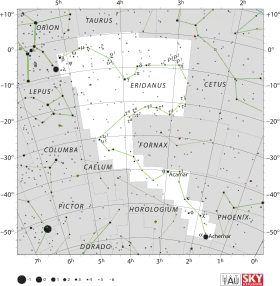Tau1 Eridani
Tau1 Eridani (τ1 Eridani) est une étoile binaire[10] de la constellation de l'Éridan. Elle a une magnitude apparente de +4,46, ce qui la rend visible à l'œil nu avec des conditions suffisamment correctes. C'est une binaire spectroscopique avec une période orbitale de 958 jours[10]. Elle est située à environ 46 années-lumière de la Terre[1]. A présent, le système s'éloigne du Soleil avec une vitesse radiale de +26 km/s[4]. Il y a environ 305 000 ans, elle fit un passage au périhélie à une distance estimée de 9,35 parsecs (30,5 al)[11].
| Ascension droite | 02h 45m 06,18710s[1] |
|---|---|
| Déclinaison | −18° 34′ 21,2149″[1] |
| Constellation | Éridan |
| Magnitude apparente | 4,46[2] |
| Vitesse radiale | +25,9 km/s[4] |
|---|---|
| Mouvement propre |
μα = +334,20 mas/a[1] μδ = +37,19 mas/a[1] |
| Parallaxe | 70,32 ± 1,83 mas[1] |
| Magnitude absolue | +3,68[5] |
| Masse | 1,15 M☉[6] |
|---|---|
| Gravité de surface (log g) | 4,34[7] |
| Température | 6 231 K[7] |
| Métallicité | −0,08 ± 0,06[7] |
| Rotation | 28,02 km/s[8] |
| Demi-grand axe (a) | ua |
|---|---|
| Excentricité (e) | 0,45 |
| Période (P) | 958 j |
| Inclinaison (i) | ° |
| Argument du périastre (ω) | ° |
| Longitude du nœud ascendant (Ω) | ° |
| Époque du périastre (τ) | 39 391,9 JJ |
Autres désignations
τ1 Eri, 1 Eri (Flamsteed), BD−19°518, FK5 2075, GJ 111, HD 17206, HIP 12843, HR 818, SAO 1557[9]
Située à la limite des constellations de l'Éridan et de la Baleine, Tau1 Eridani s'est vu attribuer une double désignation de Flamsteed correspondant à ces deux constellations, soit 1 Eridani et 90 Ceti[12].
Disque de débris
Un excès modéré d'infrarouge lointain a été observé aux longueurs d'onde 12 μm, 25 μm, 60 μm et 100 μm, par le Infrared Astronomical Satellite (IRAS) et publié en 1993[13]. Cette découverte fut ensuite interprétée comme indiquant la présence d'un disque de débris ayant un rayon proche de 500 ua. Il fut de plus spéculé que si le système avait été observé à des longueurs d'onde plus grandes, il aurait été très probable que le rayon du disque de débris soit beaucoup plus grand que 500 ua[14].
Des observations plus récentes faites par le télescope spatial Spitzer, publiées en 2004, n'ont pas détecté d'excès notable d'infrarouge autour des étoiles, dans la gamme de longueurs d'onde 14-35 μm[15].
Références
- (en) F. van Leeuwen, « Validation of the new Hipparcos reduction », Astronomy & Astrophysics, vol. 474, no 2, , p. 653–664 (DOI 10.1051/0004-6361:20078357, Bibcode 2007A&A...474..653V, arXiv 0708.1752)
- (en) J.-C. Mermilliod, « Compilation of Eggen's UBV data, transformed to UBV (unpublished) », Catalogue of Eggen's UBV data, SIMBAD, (Bibcode 1986EgUBV........0M)
- (en) H. A. Abt, « MK Classifications of Spectroscopic Binaries », The Astrophysical Journal Supplement Series, vol. 180, , p. 117–118 (DOI 10.1088/0067-0049/180/1/117, Bibcode 2009ApJS..180..117A)
- (en) B. Nordström et al., « The Geneva-Copenhagen survey of the Solar neighbourhood. Ages, metallicities, and kinematic properties of ~14000 F and G dwarfs », Publications of the Astronomical Society of Australia, vol. 21, no 2, , p. 129–133 (DOI 10.1071/AS04013, Bibcode 2004PASA...21..129N)
- (en) A. Reiners, « Rotation- and temperature-dependence of stellar latitudinal differential rotation », Astronomy & Astrophysics, vol. 446, no 1, , p. 267–277 (DOI 10.1051/0004-6361:20053911, Bibcode 2006A&A...446..267R, arXiv astro-ph/0509399)
- (en) Andrei Tokovinin et al., « Revealing Companions to Nearby Stars with Astrometric Acceleration », The Astronomical Journal, vol. 144, no 1, , p. 10 (DOI 10.1088/0004-6256/144/1/7, Bibcode 2012AJ....144....7T, arXiv 1204.4206)
- (en) C. Allende Prieto et al., « S4N: A spectroscopic survey of stars in the solar neighborhood. The Nearest 15 pc », Astronomy & Astrophysics, vol. 420, , p. 183–205 (DOI 10.1051/0004-6361:20035801, Bibcode 2004A&A...420..183A, arXiv astro-ph/0403108). Voir l'entrée correspondant à l'étoile sur VizieR.
- (en) R. Martínez-Arnáiz et al., « Chromospheric activity and rotation of FGK stars in the solar vicinity. An estimation of the radial velocity jitter », Astronomy & Astrophysics, vol. 520, , A79 (DOI 10.1051/0004-6361/200913725, Bibcode 2010A&A...520A..79M, arXiv 1002.4391)
- (en) * tau01 Eri -- High proper-motion Star sur la base de données Simbad du Centre de données astronomiques de Strasbourg.
- (en) A. H. Batten, J. M. Fletcher et P. J. Mann, « Seventh catalogue of the orbital elements of spectroscopic binary systems », Publications of the Dominion Astrophysical Observatory Victoria, vol. 15, , p. 121–295;150–151 (Bibcode 1978PDAO...15..121B)
- (en) C. A. L. Bailer-Jones, « Close encounters of the stellar kind », Astronomy & Astrophysics, vol. 575, , p. 13, article no A35 (DOI 10.1051/0004-6361/201425221, Bibcode 2015A&A...575A..35B, arXiv 1412.3648)
- (en) M. Wagman, « Flamsteed's Missing Stars », Journal for the History of Astronomy, vol. 18, no 3, , p. 215 (DOI 10.1177/002182868701800305, Bibcode 1987JHA....18..209W)
- (en) Dana E Backman et Paresce Francesco, « Main-sequence stars with circumstellar solid material - The VEGA phenomenon », Protostars and planets III (A93-42937 17-90), , p. 1253–1304 (Bibcode 1993prpl.conf.1253B)
- (en) D. A. Weintraub et S. A. Stern, « A reinterpretation of millimeter observations of nearby IRAS excess stars », The Astronomical Journal, vol. 108, , p. 701 (DOI 10.1086/117107, Bibcode 1994AJ....108..701W)
- (en) M. Jura et al., « Mid‐Infrared Spectra of Dust Debris around Main‐Sequence Stars », The Astrophysical Journal Supplement Series, vol. 154, , p. 453–457 (DOI 10.1086/422975, Bibcode 2004ApJS..154..453J, arXiv astro-ph/0405632)
Lien externe
- (en) Tau1 Eridani sur la base de données Simbad du Centre de données astronomiques de Strasbourg.

